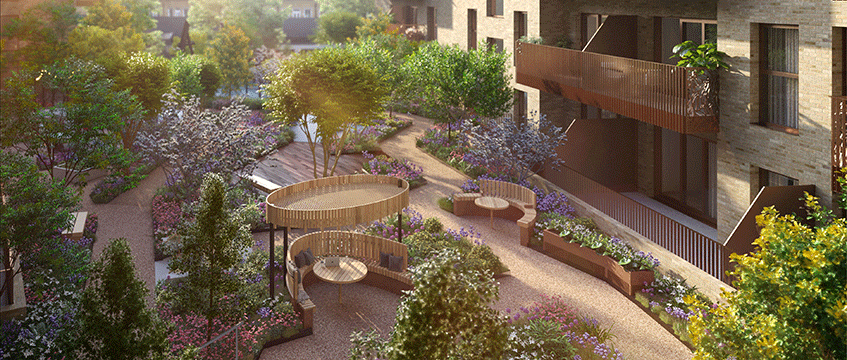Making a buzz about biodiversity
A few hives on roofs simply won’t cut it anymore.
The standard developer approach to designing in biodiversity net gain is not fit for purpose and often overlooks the role of residents and management teams in making the most of the spaces between buildings to help address London’s pollination crisis.
The warnings come in a new biodiversity blueprint drawn up by Royal Botanic Gardens, Kew, with developer Mount Anvil in response to the declining state of habitats for pollinators in growing cities.
A few hives on roofs simply won’t cut it anymore.
The standard developer approach to designing in biodiversity net gain is not fit for purpose and often overlooks the role of residents and management teams in making the most of the spaces between buildings to help address London’s pollination crisis.
The warnings come in a new biodiversity blueprint drawn up by Royal Botanic Gardens, Kew, with developer Mount Anvil in response to the declining state of habitats for pollinators in growing cities.
The partners hope the new set of metrics – the first of its kind – will be adopted by other residential developers. It is already being put into practice at Mount Anvill’s Chelsea Botanica scheme, a joint venture with housing association Peabody in the London Borough of Hammersmith & Fulham.
The scheme will have more than 70 plant and tree species to encourage a diversity of pollinators. Indeed, one problem highlighted in the Mount Anvil/RBG Kew report is that the rise of urban bee keeping, in part encouraged by well-intentioned developers, is creating a dominant pollinator species in the honeybee. There are more than 270 bee species in the UK, many of which are threatened, but the honeybee is not at risk.
The blueprint
Currently, there is no template that highlights the necessary requirements to create secure and sustainable habitats for pollinators. RBG Kew and Mount Anvil hope to fill that void with a blueprint split into four parts, each of which investigates a particular measurement that affects the stability of pollinator populations. The four components are scored according to RBG Kew biodiversity metrics so that stakeholders can easily assess their pollinator health on site.
Pollinator food resource score – This score seeks to evaluate the quantity and quality of food resources (pollen and nectar, larval food plants) available for pollinators by measuring floral cover, floral diversity, the percentage of native plant species and number of plant species supporting local pollinator species with specific needs. This pillar will reveal whether each real estate development has adequate plant life to support a diverse pollinator population.
Pollinator habitat score – This component will be used to measure the different types of habitats within a site which are beneficial to a variety of pollinator species. This will include the amount of bare soil for ground nesting pollinators, dead wood habitat, ponds or other wet habitats, stone or gravel piles and trees and shrubs. All of these represent living and breeding habitats for a variety of different pollinator types.
Site management – Understanding site management is a critical function of these measurements. Reduction of herbicides and insecticides on site will prove beneficial for all pollinator species as well as other insects which support biodiversity. Keeping designated habitats curated by reducing mowing on parts of the site will help achieve this goal, as will a designated annual site review to assess if the above criteria are being met.
Engagement with residents – A final component seeks to measure the integration of education around biodiversity within the local community, including the provision of regular information regarding on site biodiversity such as through newsletters, signs, walks and tours with ecologists. Residents will also be actively engaged with green areas on sites, like pollinator recording and participation in cultivating new microhabitats and planting seeds.
Dr Hauke Koch, research leader at Royal Botanic Gardens, Kew said: “Pollination is one of our planet’s most important biological processes. At Kew we are committed to helping ensure a successful future for pollinators and plant species.
“We hope by creating a metric to analyse pollinator value of any potential or current urban development sites, residential developers will be guided to create better places that safeguard secure and sustainable habitats for all pollinators and support biodiversity for the benefit of people and the planet.”
Chelsea Botanica case study
Mount Anvil is working with RBG Kew’s world-leading experts in pollination and nature-based solutions to design landscaping for residents at Chelsea Botanica.
This will include expert advice on plant species and habitat creation to support a diversity of pollinators and other animals, maximising the development’s biodiversity value.
During construction, RBG Kew’s research scientists will also be educating young people from Hammersmith & Fulham on the importance of biodiversity and fighting climate change.
The partnership will also provide funding for a budding scientists’ annual placement working with the scientists at RBG Kew.
Mount Anvil chief executive Killian Hurley said: “We’ve spent 31 years working only in London, unusually focused on the legacy that we leave with people in the city. We are learning how much pollinators matter to people’s wellbeing, too. Paying attention to people as well as pollinators is supremely important to me.”
To send feedback, e-mail julia.cahill@eg.co.uk or tweet @EGJuliaC or @EGPropertyNews
Images courtesy of Mount Anvil/Royal Botanic Gardens Kew











